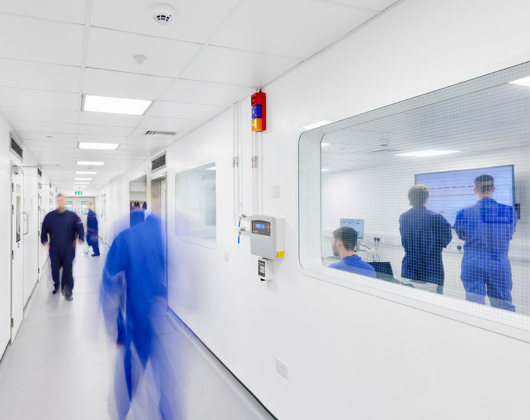At the point of candidate selection, a chosen drug substance will typically have been prepared in only small quantities (up to a few grams) to support initial medicinal chemistry activities. The synthetic route used for this initial supply is rarely suitable for producing larger quantities of material for downstream development and will typically need to be modified, or sometimes redesigned entirely, to produce enough material for first-in-human (FIH) clinical trials.
There may be several challenges to address at this point:
- The existing route may rely on chemistry that is too hazardous to be performed at a large scale, with reagents that are highly toxic, difficult to handle, or even explosive.
- It may rely on the use of solvents or reagents that generate hazardous waste or are discouraged due to environmental concerns.
- The starting materials may be expensive or difficult to procure in large quantities.
- Process impurities may be generated that are difficult to remove from the drug substance, and the existing synthesis might use purification methods (e.g. chromatography) that are impractical at large scale.
- The quantity of solvent used for a given reaction might result in poor throughput, meaning that many batches would have to be performed.
We have a state-of-the-art facility in Alnwick, UK, where we work with our customers to address these challenges with recently increased capacity.
An experienced team of process chemists works alongside colleagues in analytical chemistry and material science to develop safe, scalable, and economical synthetic routes to achieve a suitable drug substance. Each cross-functional project team is overseen by a single project manager, who seamlessly manages the end-to-end process, provides regular status updates, and ensures timely project delivery for our customers.
We work with clients of all sizes, from small biotech companies to large pharmaceutical companies, tailoring our services to meet their specific project goals.
We engage with our customers from the point of candidate selection and start by performing an initial analysis of the synthetic route.
This exercise allows our process chemists to highlight any potential red flags and identify possible alternatives.
To minimize risks further downstream, we then carry out a period of small-scale process research and development (PR&D) in the laboratory to determine the suitability of the route for scale-up, assess any potential improvements that could be introduced, and generate samples of process intermediates to support analytical method development.
We also generate data on the thermal safety of chemical processes in real-time, which allows us to make informed decisions on route selection at a very early stage in development. With access to differential scanning calorimetry (DSC), heat-flow calorimetry (HF-Cal), and online off-gassing measurements, any safety concerns can be rapidly assessed, and the necessary control measures can be introduced. This not only ensures that our chemical processes are carried out safely when scaling up, but it also reduces the risk of project delays caused by unexpected issues identified later in process development.
At this point, we may begin additional activities, such as salt screening and polymorph assessments of the drug substance, in parallel to support the synthetic route development, and to facilitate an easier transition into the formulation development phase.
The final stage of a synthetic route is typically a crystallization of the drug substance, either as a single component or as a salt. This is arguably the most important step of the entire synthesis as it controls not just the purity profile of the drug substance, but also the crystalline form or polymorph that is obtained. Different polymorphs can have significantly different physicochemical properties, and it is therefore important to make sure that a suitable solid form is identified as early as possible.
Our integrated material science team offers expert advice throughout the drug substance development process.
By performing these activities in parallel with synthetic route development, all within one organization, we can make informed decisions on the most suitable process, and make sure that we get it right on the first try for our customers.
This is part one of our three-part series focused on scaling drug substance.
Continue reading part 2: How do you streamline manufacturing of your drug substance?
Continue reading part 3: How do you successfully bridge into drug product development?
Learn more about our drug substance capabilities

